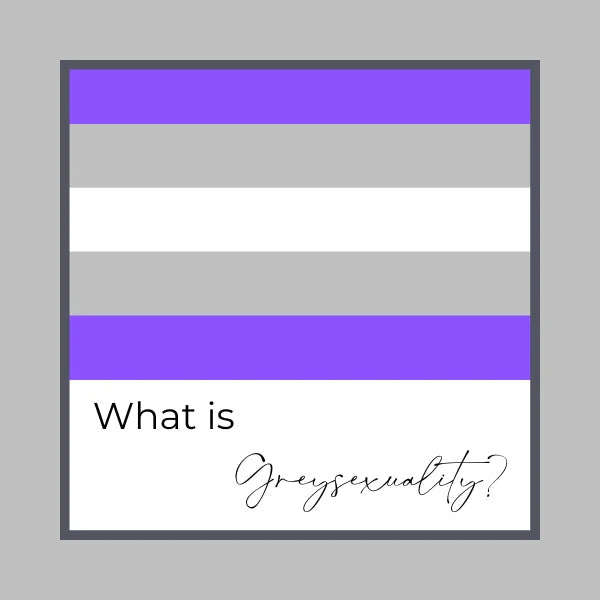
Understanding Greysexuality & The Meaning Behind the Greysexual Pride Flag
In the vast spectrum of human sexuality, there are identities that often go unnoticed or misunderstood. One of these identities is greysexuality, a term that falls within the asexual spectrum. Just as with other sexual orientations, greysexuality deserves recognition, respect, and pride.
In this blog, we’ll explore what greysexuality means and dive into the symbolism of the greysexual pride flag.
What is Greysexuality?
Greysexuality refers to individuals who experience sexual attraction infrequently or in a way that doesn’t fit into the more commonly recognised categories of sexual attraction. People who identify as greysexual may feel sexual attraction on rare occasions, or it may only arise in specific circumstances or contexts. However, greysexuality is distinct from asexuality, which involves a lack of sexual attraction altogether.
Read more on what is greysexuality.

Identities Within the Greysexual Spectrum
While greysexuality itself represents a broad category, there are several related identities that fall within this spectrum, each describing a unique experience of sexual attraction. Some of these include:
- Demisexuality. For a demisexual person, sexual attraction doesn’t arise casually or spontaneously but only when they have formed a deep emotional connection with someone. While demisexuality is a specific experience of greysexuality, it highlights how a lack of immediate sexual attraction can still lead to intimate connections.
- Lithsexuality. Lithsexual individuals experience sexual attraction but do not desire it to be reciprocated or acted upon. They may feel sexual attraction to others, but they do not want to engage in sexual activities or may not feel a need for their attraction to be mutual.
- Aegosexuality. Aegosexual individuals experience sexual attraction but may not want to engage in sexual activity or feel disconnected from the idea or acting on that attraction. An aegosexual person might fantasise about sexual scenarios or feel attraction but might not experience any desire to pursue or engage in those fantasies.
- Queerplatonic (QP) Attraction. Some individuals who identify as greysexual may also identify as experiencing queerplatonic attraction, which is an emotional connection that feels deeper than friendship but does not involve sexual or romantic attraction.
These identities illustrate how the greysexual spectrum contains a variety of experiences. Each identity represents a unique aspect of sexual attraction that doesn’t align with mainstream understandings but are all valid and valuable parts of human sexuality.
To see what other identities fall under the greysexuality, check out the asexual spectrum.

The Meaning Behind the Greysexual Pride Flag
The greysexual pride flag was created to offer a visual representation of greysexuality and to give a sense of belonging to those who identify with this orientation. It was designed by Milith Rusignuolo in 2013, and it has become a symbol of pride for those in the greysexual community. The greysexual flag features five horizontal stripes, each with a specific meaning:
- Purple: The purple stripes at the top and the bottom of the flag represent asexuality.
- Grey: The two grey middle stripes represent the varying degrees of sexual attraction.
- White: The single white stripe in the centre represents allosexuality, or the experience of sexual attraction.
The greysexual pride flag serves as a reminder that there is no one-size-fits-all definition of sexual attraction. We all experience our identities in unique ways, and each experience contributes to the complexity of human diversity.
Have a browse of our asexual jewellery.

Celebrating Greysexuality
By recognising the unique ways in which come individuals experience sexual attraction – whether frequent, conditional, or falling somewhere between asexuality and allosexuality, we can spread awareness and help foster a more inclusive and understanding environment where people of all identities feel seen and supported.
It is essential to educate others about what greysexuality is, challenge misconceptions, and create space for open conversations. Sharing personal stories, offering resources, and using inclusive language in our communities can all contribute to a culture that honours and validates the experiences of greysexual individuals. Have a read of this story about demisexuality.
Browse our LGBT jewellery to see the full collection.
Conclusion
Sexuality is a personal journey, and there is no “right” or “wrong” way to feel or experience desire. Whether you experience attraction sometimes, rarely, or only under very specific circumstances, your identity is worthy of pride and respect. By celebrating greysexuality, we celebrate the beauty of individuality and the importance of inclusivity.
Have you found our blog helpful? Stay connected with us for all the latest news and tips! Subscribe to our newsletter and be the first to receive info on new products, advice, tips, and discounts – PLUS get a free downloadable wallet card for your emergency contacts.


Leave a comment